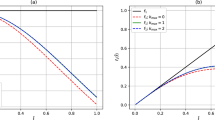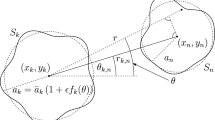Abstract
THE Earth's gravitational potential is usually expressed as a double infinite series of spherical harmonics. Analysis of thousands of photographic and laser observations of satellites, together with gravity measurements has yielded global models of the geoid1–3 accurate to about 3 m on average. The harmonic coefficients have been evaluated complete up to degree and order 16 in the Goddard Earth Models (GEM) 4 and 6 (refs 1 and 2), and up to degree and order 18 in the Smithsonian Standard Earth III(SSE)3. Models currently being evaluated will extend to degree 25 (D. E. Smith, personal communication). Although these comprehensive global solutions give the overall geoid shape or gravitational field quite accurately, the individual harmonic coefficients of order between 10 and 20 are poorly determined among the matrix of 300 or more coefficients, and accurate methods for evaluating coefficients of a particular order are badly needed.
This is a preview of subscription content, access via your institution
Access options
Subscribe to this journal
Receive 51 print issues and online access
$199.00 per year
only $3.90 per issue
Buy this article
- Purchase on Springer Link
- Instant access to full article PDF
Prices may be subject to local taxes which are calculated during checkout
Similar content being viewed by others
References
Lerch, F. J., Wagner, C. A., Putney, B. H., Sandson, M. L., Brownd, J. E., Richardson, J. A., and Taylor, W. A., Goddard Space. Flight Center Report X-592-72-476 (1972).
Lerch, F. J., et al., Goddard Earth Model 6 (in the press).
Gaposchkin, E. M., Williamson, M. R., Kozai, Y., Mendes, G., Smithsonian Astrophysical Observatory Special Report, 353 (1973).
Allan, R. R., Planet. Space Sci., 15, 53–76 and 1829–1845 (1967).
Allan, R. R., Planet. Space Sci., 21, 205–225 (1973).
Kaula, W. M., Theory of satellite geodesy, pp. 7, 98 (Blaisdell, Waltham, Massachusetts, 1966).
Gooding, R. H., Nature phys. Sci., 231, 168–9 (1971); Royal Aircraft Establishment Technical Report, 71068 (1971).
King-Hele, D. G., Nature phys. Sci., 238, 13 (1972); Space Research XIII, 21–29 (Akademie Verlag, Berlin, 1973).
King-Hele, D. G., Walker, D. M. C., and Gooding, R. H., Royal Aircraft Establishment Technical Report, 74026 (1974).
King-Hele, D. G., and Winterbottom, A. N., Planet. Space Sci., 22 (in the press); Royal Aircraft Establishment Technical Report, 73170 (1973).
Wagner, C. A., and Klosko, S. M., Goddard Space Flight Center Report, X-592-73-279 (1973).
Author information
Authors and Affiliations
Rights and permissions
About this article
Cite this article
KING-HELE, D., WALKER, D. & GOODING, R. Fifteenth-order harmonics in the geopotential. Nature 249, 748–750 (1974). https://doi.org/10.1038/249748a0
Received:
Issue Date:
DOI: https://doi.org/10.1038/249748a0
Comments
By submitting a comment you agree to abide by our Terms and Community Guidelines. If you find something abusive or that does not comply with our terms or guidelines please flag it as inappropriate.



